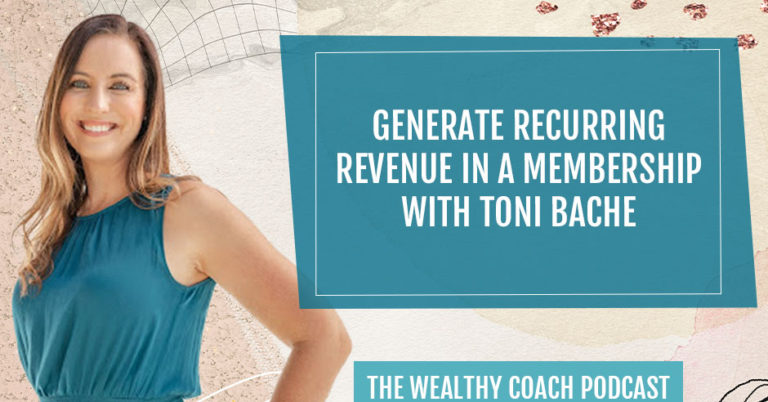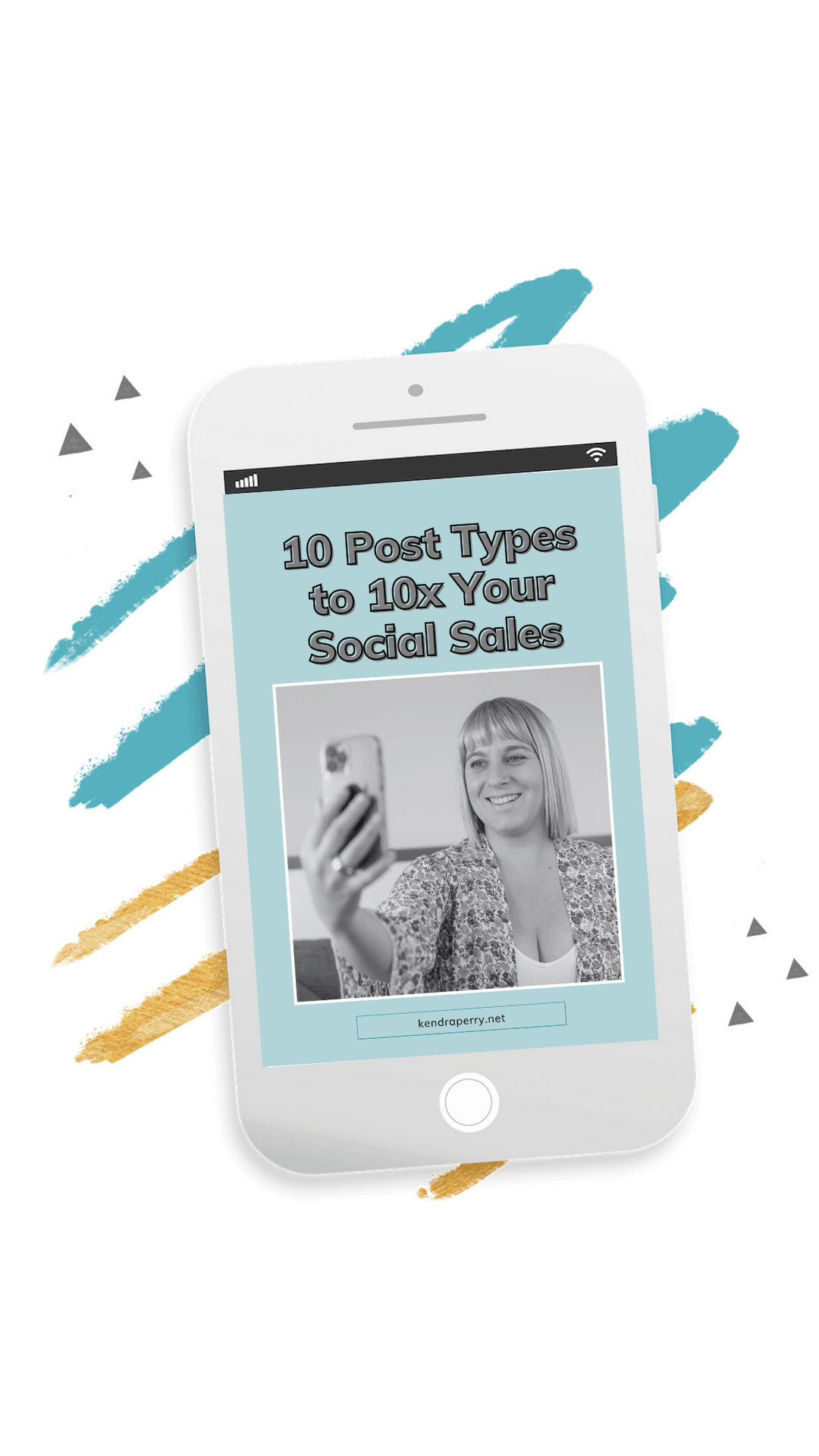What’s better than a revenue stream? A recurring revenue stream, of course! What are the opportunities and challenges of gaining a repeatable revenue stream, and how can a membership help? Kendra Perry and guest Toni Bache dive deep and explore these questions for you. Find out what it takes to build recurring profit via memberships and how to build the right tools and mindset for the job.
—
Listen to the podcast here
Generate Recurring Revenue In A Membership With Toni Bache
I am so glad you are taking your precious limited time out of your day to hang out with me. I am extra pumped up for this interview because, unknowingly, I was reconnecting with a business friend that I made way back in 2016. We lost touch, and then suddenly, I was interviewing her on this show. It was so fun to reconnect. We are talking about memberships. Memberships are something that I have never discussed on this show, but it is a hot topic because who does not want recurring revenue?
There is a ton of different ways that you can run a membership. You can run it as a standalone. It can be on the backend of your private coaching or a course. It can also be the front end and then sell into a course, or when I was a health coach, I had a health membership and I made my money on the upsells. I sold lab testing and supplements inside the membership.
Memberships are pretty cool. I have a few opinions about membership, as does Toni. We are going to dive into that in this episode. We are going to talk all about what a membership is, how it differentiates from a course, the different types of membership options that are available to you, how to make your membership the best, and how to make sure that you keep your membership retention high, meaning that you prevent people from unsubscribing and canceling their membership from your program.
Here is a little bit more about Toni. Toni is not your average seven-figure business coach. She is a vivacious Australian helping busy women build and scale online businesses without sacrifice. She is obsessed with memberships because of the freedom, flexibility, and impact they can create. Toni has made it her mission to create a movement inspiring female founders to create $1 million-plus memberships without the hustle.
She has all the pieces of paper. She has a Bachelor in Business and MBA, studied Leadership at Harvard, and she is a Professional Certified Coach through ICF, a Board Certified Coach, a Certified Executive Coach, and a Strengths Certified Coach, but maintains that none of these things are as valuable as the experience she has gained scaling her own business and helping hundreds of clients scale their own.
She left a lucrative global vice president role in a Fortune 100 company where she was responsible for large teams and multibillion-dollar deals to enjoy the membership business she had created and to free up her time to focus on helping other women do the same. When she is not busy coaching inside her memberships, she can be found renovating homes, training for the 29029, or volunteering her time on the beach as a surf lifesaver. Let’s not waste any time. Let’s dive into this interview with Toni.
—
Toni, welcome to the show.
Thank you so much for having me, Kendra.
I am so excited you are here. We booked this interview, not realizing that we knew each other. We have realized that we met in something called the Funnel Playground, which was this membership run by two female entrepreneurs. Do you remember when that was?
It must have been 2015 or 2016. It is quite a while ago now.
We were in this membership. We collaborated on something because I remember being a guest expert in one of your groups, but I do not remember if you were a guest expert in my group.
It was one-way. Now, I am returning the favor many years later.
It was your podcast manager or PR person that had applied. I saw your name and I was like, “I know this name.” I walked away, came back, and could not get it out of my head. I was like, “I know this person,” and I could not figure out how, and then it popped into my head. I remember when I was a guest expert for your membership or group, I had gone to the dentist after not being to the dentist in more years than I care to share, and because of all the plaque build-up, they had gone to town. I was swollen.
I did not realize it. I thought you were amazing. I remember all of the women inside my membership thought you were incredible as well.
That is the backstory on me and Toni. Why don’t you share with our audience how you got into the space you are in and help people build their membership programs?
I had always been in business coaching and had always had an entrepreneurial spirit. I was working in corporates and coaching inside corporates and then outside the corporate side, I already had these little side hustles in all sorts of different arenas over the years. I do not know if I was technically burnt out, but I had gotten to that exhaustion point and I was really sick. I have been to all the doctors. They could not figure out what was wrong with me. I did not go and speak to a brilliant integrative health specialist at that time. I did not even know what they were. Intuitively, I thought I had got to look after my own health because traditional medicine was not doing it.
One of the things I decided I needed to do was exercise more consistently. I had been in that pattern of being too busy or I will set the goal to exercise three times a week, but the exercise was defined as going to the gym, sweating it out, and being crazy. I thought I had got to change something and do something different, so I said, “I am going to exercise every day for 30 days. It does not matter if it is 5 or 10 minutes and what it is.” I did that for 30 days, 30 days became 60 and then became 90. I ended up doing it for a full year.
At the end of that year, my husband said to me, “You should write a blog post about this.” I would never write a blog post in my life. He is a marathon runner and has a blog about his marathons. He is like, “Write it on my blog.” He has blogged about his marathons and only family and friends read it. It was not a successful blog or anything like that.
I was still working in corporate. I sat down before work one morning and I bashed it out. There was no editing, no thought into it, no structure, and thought nothing more of it. I shared it on my personal social media. I had no business social media or anything. I still do not know the exact circumstances, but it ended up getting picked up by Arianna Huffington’s publication, Thrive, so then thousands of people around the world were reading my crappily thrown together blog article about what it meant to me to exercise for every day for 365 days and it went from there.

A whole bunch of people reached out and said to me, “I want to do the same thing. Can you help me?” I already had the entrepreneurial spirit. I did not know much about online business back then, but I was like, “I can see this being an opportunity.” In the space of two weeks, I decided that I was going to create and market the course. I built a website and the course. I did all that. I spent $50 in the process on my hosting and setting up my email CRM and I launched this course.
I had over 300 people doing this course. I did not know that if I was sharing something on my personal socials, I was only spending $50, and I get 300 people was good. From there, the course turned into membership because I realized I wanted to help these people more and what I had given them in the course was not enough. I want to make sure they implement it and be part of their journey.
It evolved into membership, but I thought I created memberships because I was like, “I have got this crazy idea. How about instead of you just paying me for the course, what if you pay me a little bit every month, I can give you new information, help you, and support you?” That became this membership before I even knew memberships are a thing. It turns out that I did not invent them and it was already a thing, so I went on that journey.
I had already been doing this business coaching in corporate. Now, I had this very successful life coaching membership because it was all around helping busy women set goals, get goals and improve their energy and their time management. I had a lot of people saying, “You have set up this successful membership. Can you help me do the same thing too?”
For a few years, I was juggling both and managing the business that was the life coaching and on the side doing the online business coaching, and then I realized my passion has always been business. It lights me up. I am the girl at the barbecue that you can’t shut up about a business idea even when you do not want to hear it. I made that switch. We were trying to talk about it before, but it probably was 2019 when I finally went into it and went all-in on business coaching versus life coaching. I had been doing both for a little while.
From the business coaching, I realized that most women do not want to have this based on famine of up and down in their business. They want to have a bit more reliability and consistency. They do not like selling, so if they can sell once and not have to sell ever again, they are happy about that. I was already known for the membership model and a lot of people in my audience already had the membership model, but I leaned into that more when I realized how aligned it was with the women that I worked with, the goals they were trying to achieve in their business, and being able to scale their business without sacrificing time with their family.
I love that so much. It is funny we both transitioned into business coaching in 2019 and then found each other again. Let’s dive into membership. Can you tell me what a membership is and how it is different than an online course?
Honestly, you could probably talk to a lot of gurus that would tell you there are a lot of differences, but there are two big ones that are important. One is the recurring revenue piece. This is the most important piece because you sell a course and you sell it once. You take your money for your course, you deliver your course, and that person has a great experience, but then in order for you to get more money, you have to go and sell that course again and again.
You are constantly on this cycle that for you to make money, you have to sell every time, whereas the significant difference with membership is that you sell somebody in once, but because it is recurring revenue, they continue to pay you each month until they cancel their membership. You will have this recurring revenue that you do not have to fight and It comes naturally every single month. You are getting extra money in the bank. That is the most significant difference.
There are certainly some differences inside of membership. You can tend to focus a little bit more on implementation, whereas courses are more information, but there are so many different types of membership that you get to choose how your membership looks. I always bring it back that recurring revenue is the biggest difference.
You mentioned that there are a lot of different types of memberships. Maybe we can dive into the different ways that you can run a membership, so our audience gets an idea of what is possible.
The biggest challenge is there are no rules in business and memberships. You can design your membership to be whatever you want to be. I have a client who has a membership that she is not involved in any way, shape, or form. She does not present or create any of the memberships. She does not do any live things inside or no community inside her membership, yet, she focuses on setting up the people to build this stuff inside the membership and the marketing, and she has an incredibly successful membership.
On the flip side, I have clients who have memberships who are constantly inside the membership coaching because that is what lights them up. We have got people that have front-end memberships that would lead into a course or backend memberships where you have a course on the front end and then you have a membership or a standalone membership. There are so many different types of memberships, but also, there is no limit to how you can set up your membership.

My philosophy is always you have to design your life before you design your business. You have got to look at how much money you want to make or your freedom metric. What flexibility do you want to have? When do you want to work? Where do you want to work from? Who do you want to work with? You then want to look at your fulfillment. What do you love? What lights you up? What is the stuff that juices you that you love doing? Based on that stuff, that is when you pick the model for your business. If it is a membership model, that is when you define what your membership will look like to serve you and serve your ideal clients.
I love that you talk about designing your life and that there are all these different ways you can set up a membership because I feel like people think they have to do certain things for a membership. I know that when I started my first membership, I thought, “I need to do three Q&A calls a month and then one live training.” What ultimately happened with that is that after a year or more, I was like, “I do not know what to do for the live training anymore because I have covered every topic.
Exactly, or you feel like you are on that content creation treadmill because every month or every week, it depends on what you set up, you have to create something new. If you like doing that, that is great, but if that is not you, then that is not going to be great, so that is not how you want your membership set up if that is not you.
It sounds like one of the biggest benefits of membership is this recurring revenue. Recurring revenue sounds super sexy. Everyone who is reading is like, “I want recurring revenue.” Can we speak to some of the cons of membership and situations where someone might not want a membership?
I am pro membership, so there are a lot more pros than cons in my mind. I am sure there are some that you can think of, and feel free anytime to reach out and go, “This is the con I am scared of. What do you think?” I am always very honest, but sometimes, I am maybe oblivious to some of the cons. The biggest thing is you have to know what you want it to do for you and how you want it to be set up for you, because where I see people get stuck is they do what you did and believe like, “I have got to do these Q&A calls and this teaching call.”
They feel like a slave to their membership because they have to be there every Tuesday at 10:00 AM. They are like, “I want to travel. I might not feel well that day. I only like doing live stuff, but I am now setting myself up to do this pre-recorded stuff all the time.” The cons tend to come down to not membership being a con, but maybe the way you have set it up has not aligned with the lifestyle you are trying to build or the stuff you enjoy doing.
I do not know if it is a con, but it is a real watch-out that memberships can feel like a con when you feel trapped and have to be a slave to the membership. The other thing that can be a real con that I see is that sometimes, people jump in and do a membership too early where they go, “Toni said memberships are amazing, so I should jump in and do a membership right away,” but they haven’t thought about whether they want to have those continual deliverables or how they have set it up. They then feel trapped like, “I committed to membership. A membership is a long-term thing. I wish I would have done a course.”
They are all things that can be avoided with proper thought, consideration, and setup. Most people that do not love their memberships are like, “I feel like I set up the wrong thing. It is not what I wanted it to be, but now I feel trapped in it. I love my membership, but I feel like it is not serving me because I have to show up all the time. I feel like I am on this hamster wheel,” or sometimes, you get like, “I love the creation, but I hate the marketing.” It is not a con for memberships. It is the same with courses. If you like delivering and you hate marketing, it is going to be hard to sell. Those are the three typical things I hear.
The other thing I hear is also a bit of a misnomer, but people are like, “You have to have a cheap membership. You got to be $27, $37, or $47 a month.” That is not entirely true. You can choose whatever price point you want. You have just got to have the value to match that price point. I do not know if that fully answers because they are all things you can avoid, but I think they are the watch-outs to be cautious when you are thinking about a membership. You have to think, “Does that really serve me or is there another better model that is going to serve me better?”
It is important that you mentioned pricing. I have a course in mentorship that serves new coaches. We always start them on high-ticket one-on-one coaching because they typically need money. They have no audience. That is going to be the fastest way to get them to six-figures, and then from there, they can do the course or membership.
I get a lot of people who come to me who have set up these memberships. They have no audience and they are charging $37 a month. They are like, “I am broke,” and I am like, “I understand why.” You do need a certain amount of volume, but on the other hand, what I have my clients or students do is when they have their signature program, and maybe it is a 90-day program, if people want to continue working with them, I recommend that they put them on a subscription model where they get one appointment a month and some support to create that recurring revenue. That way, they do not have to create this whole next-level program.
That is such a perfect model. What you are working with your clients is so aligned with what I believe because you have to start with one-on-one. This was my journey as well. You start with that one-on-one and you get to learn what you are good at showing people, what you are saying that is connecting with them, and who you love working with. The one-on-one is your learning ground to learn everything you can then take forward into your leverage program. Once you have got your head around that and you are like, “I do not want to exchange time for money forever. I want to leverage myself,” that is when you start to go more online and go into more of a program style where you are doing one-to-many instead of one-to-one and then that can be a course, a program, a group coaching, or a membership.
It does not matter what it is at that stage, but that is when you have got to take them on that journey to go from one-to-one to one-to-many. I think where memberships fit well is they can either be off the backend of a course and you do the course to what you said, like, “Here is all of the information in the course. You can have that for 90 days. After that, you can join my membership where I will support you on the implementation of that content and you will retain access to that content.”

That is a perfect model. Alternatively, you can go straight into a recurring revenue model because sometimes, you are like, “I do not want to have to resell them at the end of the course. If I sell them in at the beginning and get them committed to this, then I have the recurring revenue.” There is no right or wrong. There are no rules in business, but it is a matter of what feels aligned for you and what feels like the right model for you to go within your business.
You mentioned the model that I use, which is I sell the course mentorship on the front end and then people can pay to stay and get help more with implementation. Implementation is very much needed. We can give people the information, but people can’t usually bring it in all at once and they need help with the trials, tribulations, and troubleshooting that come up along the way. That is what I do for the audience who are interested. I would love to talk about the churn rate. For the readers, the churn rate is the percentage of people who are leaving your membership every month. It is a sticking point with memberships because it is this retention piece. It is like, “I have sold them into it, but how do I get them to stay?”
The model that I teach is three components to making your membership successful. One is the attract, which you touched on before that sometimes people are like, “I am not making any money because I am selling this $37 product, but no one is buying it,” but they do not have a big, enough audience to even be selling it to in the first place. You have to make sure you have the audience or ideal customer and are priming them to purchase from you.
The second one is to convert and make sure you have got that irresistible offer they want and desire. The last section is retain. That is the section that people forget about because it is so focused on converting people and then they are like, “I am not converting enough people. I need to attract more people.” They are on this cycle of forgetting about the people that they have already got.
The people you have already got are your raving fans. They are the ones that will love hard on you and tell loads of other people. It is important not to forget about the retention piece. One of the tricks that I tend to teach a person that I work with in setting up their first membership is what I call a dirty beta and doing it scrappy. One of the things I recommend is that I sell it as an annual rather than a month for the first time. Otherwise, your mind explodes because you are trying to get this thing off the ground and set up and you have got to worry about retaining people as well.
I would be like, “For the first one, go annual and go cheap because you will be underselling yourself, but you will then have these people to learn from and test different things within your dirty beta. You then can go month to month when you launch it the second time and then focus on retention strategies.” The retention strategies are not difficult. It is about building a connection with your people so that they love you and they want to stay around. It is about building community. People come for the content thinking, “I want to learn X, Y, Z,” but they stay for the community because they build those connections not just with you but also with the other people.
The other thing is making sure that you have really interesting content strategies so you do not leave them in this routine where it is boring, but you throw in different things so that they are starting to taper off. Every six weeks, you have something a little bit off-piece, so they are like, “This is cool.” You tease them and do some internal marketing about letting them know what’s coming up. You have to look at your external marketing and your internal culture and marketing. Make sure that you are creating a culture where people want to stay within the community and you are being strategic with telling them what’s coming next so that they want to hang around for it.
I am very pleased that you mentioned the beta test because I harp on the beta testing for everything. I even have my students do it for their one-on-one program. I am like, “Run it as a beta. Do it for cheap. You are not getting rich off the beta because all the stuff that is in our head that we want to teach does not always translate when we try to teach it to people who do not have the same knowledge as us.” Teaching is a complex and important skill. It is not something that you are naturally good at, especially if you have never gone to a teacher’s college.
I find that health coaches look at what they were taught in health coaching school and then try to teach the same stuff to their clients. Your clients do not want to be health coaches. They want to get the results. There is a lot of testing that goes back and forth with that. It is really important to test everything and see exactly how it is going to land with people because how you truly make a course or a membership the best in your space is by co-creating it with your students.
That is something I learned from Lindsay Padilla, who is both our mentor. I think it was her Build a Better Beta program. I love this thing where she talked about you co-creating your course with your students by constantly asking for feedback and interacting with them. I have done that for every single program I have run since.
I could not agree more with anything you said. Everything I have launched, I had done it in that way even when I did not realize that is what I was doing. I have now always coached that way as well as you do. The goal of it is not to make money. The goal of it is to learn. If you go in and go, “The goal of this is to learn who my ideal customer is, what they want, and how I should structure things to co-create it,” you are transparent about that. In exchange for them being your little test project, they get this massive discount and more access to you because as you are co-creating, you tend to give them a bit more of your time and energy than what you would further down the track. It is this fair value exchange, but it is amazing for you.
The better thing and why I am so passionate about people doing betas is that when you are learning, you are not earning. You are constantly learning, “How can I make this a better course? How could I make this a better membership? How could I do this and that? I better perfect this and that.” You are learning in theory, but you are not learning in practice. The best way to do it is to go out there, and make some mistakes. That is the best way to do it rather than getting it perfect in your head.
I am going to physical therapy to recover after surgery. In every physical therapy session, I have my physiotherapist picking my brains on stuff like, “I have got this amazing idea for a course or membership, so I am writing it all out and I am building the whole thing. It will take me a year to get it all built.” I am like, “Launch it next week. You have got people asking for it. Launch it and co-create it. Present it live the first time. See what will work and what does not.”

Imagine spending a whole year doing what you think is perfect, recording all of these different sessions, and getting to the end of the year. You try to sell it and nobody wants to buy it because you realize it is not what they wanted, or they buy it, do it, and they do not like it. You have invested all of this time, energy, and money. It makes no sense. Do not go and perfect this thing and then do it. Learn on the job while you are doing it.
You gave away the exact process that I teach inside my course group program academy that teaches my students how to launch their first group coaching program. It is all about the beta. It is like, “Test it, launch with your idea, run it live, get the feedback, and then decide where you want to go from there.” I feel like we are sharing a brain. I have one more specific question about churn and retention. I am trying to bring down my churn rate AKA retain my people for longer. What would you say are the three most important things that I should consider when trying to improve my retention?
Number one is to ask them what they want. I am sure you teach that when you are doing your beta, get on the phone with people, send them surveys, or ask them questions to learn about what they want. Once they are inside your membership, you forget to ask them what they want. It is almost doing a reverse exit interview. While they are still there, ask what do you love about this membership? What do you think could be done differently or better? How likely would you be to recommend this membership to a family member or a friend? That last question is your net promoter score. If there is anything under an 8 or a 9, then they are at risk. You want to know who those at-risk people are.
The first thing is knowing where you are. Do you have a lot of people at risk and then also get that feedback and information from them. The second thing is community. How can you make your community even more attractive and appealing to people that they never want to leave? Forget about your content or your coaching, but what can you do to facilitate a community of amazing health coaches coming together to talk about how they can up-level their business? The community alone is worth them paying. I am in a community and I pay $2,500 a month for that community. They do teach content and stuff, but that is not why I am there. I am there for the community.
You have to think about why they would want to stay and pay purely to be in that community, how you can facilitate amazing discussions, and how you can provide enough value to one another that they want to stay for just the community. The last thing with your content/coaching is if you have the same routine every single month like, “On Fridays, we do this coaching call.” People get a bit bored and immune to it and their interest wanes. When they see results and they are seeing progress, they want to stick around. When they are not seeing progress, they do not want to stick around.
I know you and you are amazing, but I can tell you that they are not making progress because they are not implementing what you are telling them to do. You have to mix it up to break their pattern and have them re-engage so that you can get them recommitted, they can implement, get results, and see more progress. Does that make sense?
Absolutely. I love that. That is great advice. The other thing I have been working on is the students’ sequence, like sending out regular communication and reminding them of what to take advantage of. A lot of the time, people forget about the things they have access to. That is the main reason why people cancel a membership. They are like, “I am not using it.”
The number one reason that people leave is that they are either overwhelmed by it because you are giving them too much and they do not know what to do. They start to feel like a failure because they are not doing it or they are not showing up. You have got to make sure how you can make it simple and easy and how you can drive them to show up. If they are showing up, they are loving the community and getting results. They are never going to leave.
I would say that it would come down to the timing of when people are leaving, but your onboarding process in memberships is so important. Something to look at is the onboarding process, but also your off-boarding. Rather than going like, “Do you want to cancel? See you later. Bye,” saying, “I am sorry that you want to go. Do you want to jump on a call with one of our coaches to help you work through whatever your struggle is?” Of course, you are not going to try and trap them, but it is about caring about your people enough. It is not about the money. It is about caring about them enough that you want to help them succeed.
With all of your conviction in the core of your soul, you know that the best place for them to get the best results is working with you. If you let them off, you let them down. If you let them cancel without you chatting to them, and when I say chatting, it does not have to be a physical phone call but having some dialogue with them about why are they leaving, what can you do to better serve them, and what could you do differently to make them stay.
If you do that, you are letting them off and then you let them down because you are allowing them to either let go of their health coaching business dreams or go and work with somebody else that inferior to you, which is also not good. You have got to have that conviction and belief like, “I want them to stick around and save them before they go.” Doing that exit interview while they are still there is a good way to try and catch them before they go, but having processes on the backend when they go is also important.
If people want to stalk you online and binge all your content about memberships, where can they find you?
Find me on Instagram or Facebook. That is where I hang out. Instagram is my preferred platform to chat with people. You are always welcome to ask me any questions. Check out anything I have to say about memberships or my strong views on online business in general. I would love to connect with you and continue the conversation.
Everyone, go follow Toni. I also want to thank all of you for taking time out of your day to tune in. I will see you again at the same time and same place where I will help you become a wealthy AF.
Important Links
- Toni Bache
- Build a Better Beta
- Instagram – Toni Bache
- Facebook – Toni Bache
About Toni Bache
 Toni Bache is not your average 7-figure business coach. She is a vivacious Australian helping busy women build and scale online businesses, without sacrifice. She is obsessed with memberships because of the freedom, flexibility and impact they can create (did anyone say recurring revenue, while only working a few hours each week?). Toni has made it her mission to create a movement inspiring female founders to create $1M+ dollar memberships without the hustle. She has all the pieces of paper – a Bachelor of Business, an MBA, she studied Leadership at Harvard and she is a Professional Certified Coach through ICF, a Board Certified Coach, a Certified Executive Coach and a Strengths Certified Coach – but maintains that none of these are as valuable as the experience she has gained scaling her own businesses and helping hundreds of clients scale their own. She left a lucrative global Vice President role in a Fortune 500 Company where she was responsible for large teams and multi-billion dollar deals to enjoy the membership business she had created and to free up her time to focus on helping other women do the same. When she’s not busy coaching inside her memberships, she can be found renovating homes, training for 29029, or volunteering her time on the beach as a surf life saver.
Toni Bache is not your average 7-figure business coach. She is a vivacious Australian helping busy women build and scale online businesses, without sacrifice. She is obsessed with memberships because of the freedom, flexibility and impact they can create (did anyone say recurring revenue, while only working a few hours each week?). Toni has made it her mission to create a movement inspiring female founders to create $1M+ dollar memberships without the hustle. She has all the pieces of paper – a Bachelor of Business, an MBA, she studied Leadership at Harvard and she is a Professional Certified Coach through ICF, a Board Certified Coach, a Certified Executive Coach and a Strengths Certified Coach – but maintains that none of these are as valuable as the experience she has gained scaling her own businesses and helping hundreds of clients scale their own. She left a lucrative global Vice President role in a Fortune 500 Company where she was responsible for large teams and multi-billion dollar deals to enjoy the membership business she had created and to free up her time to focus on helping other women do the same. When she’s not busy coaching inside her memberships, she can be found renovating homes, training for 29029, or volunteering her time on the beach as a surf life saver.






